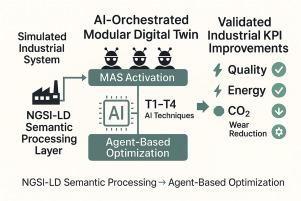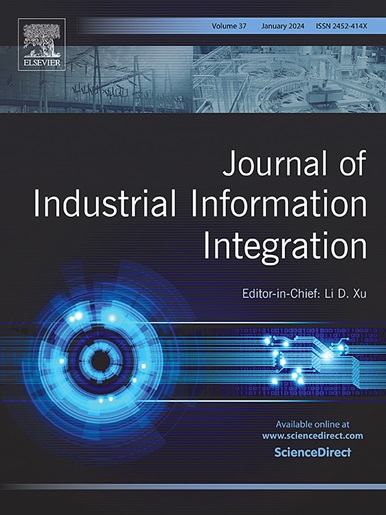人工智能驱动的数字孪生的语义和模块化编排,用于工业互操作性和优化
IF 10.4
1区 计算机科学
Q1 COMPUTER SCIENCE, INTERDISCIPLINARY APPLICATIONS
引用次数: 0
摘要
数字孪生(DTs)是智能制造的基础,支持数据驱动的监控和优化。然而,许多实现仍然是单一的,限制了互操作性和可重用性。本文介绍了用于编排ai驱动的dt的语义和模块化架构,旨在实现跨工业系统的可扩展集成和标准化协调。该系统采用与NGSI-LD一致的语义API,以暴露工业实体,如流程、异常、资产和上下文kpi(例如,能源使用、二氧化碳排放、工具磨损、产品质量)。从阈值调整到符号学习的人工智能技术被封装为模块化代理,每个代理执行有针对性的优化任务。这些代理在语义API上操作,这确保了模块之间一致的、可解释的交互。定义了一个Manager和一个推荐人代理来协调执行;虽然还没有在运行时部署,但它们的逻辑是通过支持可跟踪的模块化激活的语义接口实现的。利用模拟加工、装配和检测任务的综合数据对系统进行了验证。结果显示,在每个模块激活后,可持续性相关kpi得到了可测量的改善。更重要的是,语义编排层支持模块化、互操作性和AI重用。这项工作为下一代dt提供了符合标准的基础,支持与FIWARE、Catena-X和IDS等生态系统的集成,并符合工业4.0和5.0的原则。本文章由计算机程序翻译,如有差异,请以英文原文为准。

Semantic and modular orchestration of AI-driven digital twins for industrial interoperability and optimization
Digital Twins (DTs) are foundational in smart manufacturing, supporting data-driven monitoring and optimization. Yet, many implementations remain monolithic, limiting interoperability and reusability. This paper introduces a semantic and modular architecture for orchestrating AI-driven DTs, designed to enable scalable integration and standardized coordination across industrial systems. The system employs a semantic API aligned with NGSI-LD, to expose industrial entities such as processes, anomalies, assets, and contextual KPIs (e.g., energy usage, emissions, tool wear, product quality). AI techniques ranging from threshold adjustment to symbolic learning are encapsulated as modular agents, each performing targeted optimization tasks. These agents operate over the semantic API, which ensures consistent, interpretable interactions across modules. A Manager and a Recommender agent are defined to coordinate execution; while not yet deployed at runtime, their logic is implemented through semantic interfaces that support traceable, modular activation. The system is validated using synthetic data simulating machining, assembly, and inspection tasks. Results show measurable improvements in sustainability-related KPIs following each module’s activation. More importantly, the semantic orchestration layer enables modularity, interoperability, and AI reuse. This work contributes a standards-compliant foundation for next-generation DTs, supporting integration with ecosystems such as FIWARE, Catena-X, and IDS, and aligned with the principles of Industry 4.0 and 5.0.
求助全文
通过发布文献求助,成功后即可免费获取论文全文。
去求助
来源期刊

Journal of Industrial Information Integration
Decision Sciences-Information Systems and Management
CiteScore
22.30
自引率
13.40%
发文量
100
期刊介绍:
The Journal of Industrial Information Integration focuses on the industry's transition towards industrial integration and informatization, covering not only hardware and software but also information integration. It serves as a platform for promoting advances in industrial information integration, addressing challenges, issues, and solutions in an interdisciplinary forum for researchers, practitioners, and policy makers.
The Journal of Industrial Information Integration welcomes papers on foundational, technical, and practical aspects of industrial information integration, emphasizing the complex and cross-disciplinary topics that arise in industrial integration. Techniques from mathematical science, computer science, computer engineering, electrical and electronic engineering, manufacturing engineering, and engineering management are crucial in this context.
 求助内容:
求助内容: 应助结果提醒方式:
应助结果提醒方式:


